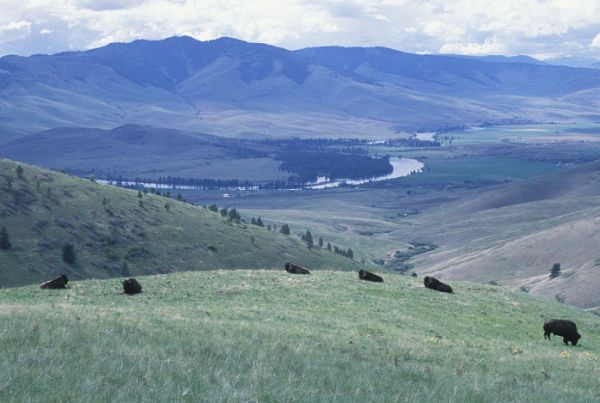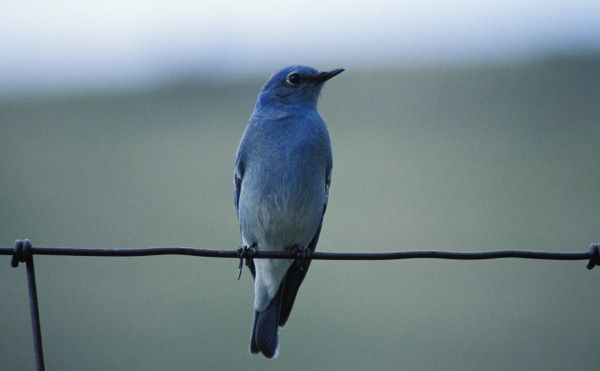As the name suggests, the National Bison Range is mostly known for its large mammals. Besides the American bison that the refuge was founded to protect, there are pronghorns, elk, bighorn sheep, mule and white-tailed deer, and black bears. There are also rattlesnakes, amazing views, fascinating tales of history and prehistory, and of course, many birds.
Are the bison the stars of the show, or is the real star the range itself? It’s hard to say.
Nearly all of the above made their presence known when I joined my boyfriend and his folks on a tour of the Range’s Red Sleep Mountain Drive, but as usual I was mostly interested in the birds. Birding from a car can be challenging, but since the habitat is delicate and since idiot tourists and megafauna can mix badly there are few walking trails in the park and you have to take what you can get. On the plus side, that means that the birds are rarely disturbed and are fairly confident.
Things started on a promising note, with Mountain Bluebirds and the pale local race of Song Sparrow both evident in the visitor center parking lot.
The habitat, chosen as it was to support ungulates, is mostly Palouse prairie with the attendant grassland birds. To my disappointment the biggest and most visible species I saw was the introduced Common (Ring-necked) Pheasant, and my first lifer was the equally introduced Gray Partridge. In fact, I realized, since the Wild Turkey is also not a native species here I have not seen a single native game bird since I came to Montana – a rather disturbing bit of evidence of how hunting interests can trump conservation and science if not watched carefully (as if the need for a national bison range in the first place was not evidence enough.)
More enjoyable was the arrival of an American Kestrel – not the Prairie Falcon I was hoping for, but it put on a good show and was easy to point out to the others in the car as it hovered for prey. There were also good numbers of Western Meadowlarks, and an obliging Eastern Kingbird who held up traffic while the tourists ahead of us tried to takes its picture.
Although prairie is the primary habitat type, the mountains are the most notable landscape feature. It’s the 10% grade and the switchbacks, as well as tourists stopping to take pictures, that make the drive’s 19 miles take up to two hours. These mountains provide more forested habitat where we encountered another pair of Mountain Bluebirds and some Townsend’s Solitaires, although not the dramatic purplish Lewis’s Woodpeckers which nest there. I was sure those would have been a crowd-pleaser, but instead I was reduced to teasing the boyfriend by pointing out American Robins. This was not a very successful prank, especially since we had just encountered a large cinnamon-colored black bear which was much more interesting, even to a birder.
After crossing reaching the mountain-top and taking in spectacular views of the badly flooded Jocko and Flathead Rivers, there was nowhere to go but down. Only literally, fortunately, as the other side of the loop provides the best viewing opportunities for the park’s wetlands. Most of the deer were in or near the lush and very wet wetlands, preparing to or just having given birth. We also saw a number of female pronghorns in the same condition, including one with a pair of twins who must have been a few days old at most. Perhaps it was the promise of afterbirth that drew so many Black-billed Magpies to this side of the park. And although the single Bald Eagle we spotted just outside the park was probably more interested in fish, they are known to enjoy fawn as well, when they can carry it.
Unfortunately, flood conditions had washed out many of the edges and reed beds where I would have hoped to see Gadwalls and Goldeneyes, Yellow-headed Blackbirds and Wilson’s Phalaropes. I did spot a handful of Blue-winged Teal, and on a fencepost a single Wilson’s Snipe – my second and final lifer of the day.
Perhaps not the most spectacular list in the world, but combined with the amazing mammals – we also saw bison, of course, plenty of them although scattered about in relatively small groups – the views, and the general pleasure of being on a short road trip with enjoyable company, it was an afternoon well-spent. And a more determined birder could have come away with far more, especially earlier in the spring: the park’s checklist numbers over 200 species. If you’re in the area, perhaps passing from the better-known Yellowstone to the better-known Glacier National Park, I highly recommend a visit.
So does this guy:
Images by Jesse Achtenberg, courtesy of the National Fish and Wildlife Service.













I had not heard about the National Bison Range–looks beautiful! Great picture of Mountain bluebird and a pretty wild story on your link about the fawn.
You reminded me of my experience last summer at Oklahoma’s Tall Grass Prairie Preserve. Apparently, this is not a well-known preserve because Oklahomans to whom I spoke thought I was referring to the National Tall Grass Prairie Preserve in Nebraska. I first visited two summers ago. Last summer, I was able to take my wife hoping to give her some closeup views of Oklahoma’s state bird, the scissor-tailed flycatcher and the bison that also live on the preserve. The flycatcher was easy, but the bison were more uncertain. When we decided we finally had to leave, we took one more road to the north out of the preserve. No more than 1/2 mile from the Visitor Center, we were driving through a herd of bison on the road. Driving slowly felt safe, but we returned to the Visitor Center to tell them of our sighing. We left again and after passing the bison, we encountered thousands of barn swallows along about 1/2 mile of the gravel road. They were on both sides of the road and completely covering the road. As we drove through, they would fly up and then back down as soon as we passed. Thoughts of Hitchcock. I was born and raised and continue to live in the Pacific Northwest. Spending time in Oklahoma the last two summers has opened my eyes to the excitement of a new kind of diversity.
Yes, this is certainly not the most spectacular list in the world, but who’d care about that detail after seeing a Mountain Bluebird.
As a kid, long before I turned into a birder, my dad used to buy me big flashy picture books about the world’s animals for birthdays and christmas. To this day, I remember once turning a page and looking at the picture of a Mountain Bluebird perched high on a spruce tree in a mountain scenery. I was completely overwhelmed by the sight.
I’ve have not made it to the west of North America yet. Therefore, you could have simply written: “We got out of our cars, spotted a Mountain bluebird, and then a thick fog set in, we couldn’t see anything anymore and were forced to return home immediately. What an AMAZING day!!” And I’d agree.
Thanks for the lovely story. I’ll miss the abbreviation “IT” though.
@Anne: It is a beautiful place, and I’m surprised that it’s not better-known.
@David: And I in turn had never heard of the Tall Grass Prairie Preserve. Sounds wonderful – I can never get enough of Scissor-tailed Flycatchers.
@Jochen: It’s amazing how those childhood images of birds stick with us, isn’t it? If you’re ever in Montana in early summer, I think you can feel pretty confident of seeing a Mountain Bluebird. Of course, you will probably have to climb a mountain.